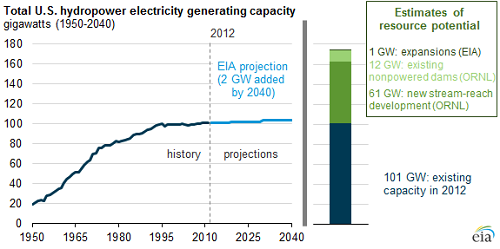A new study by the Department of energy shows there’s great potential for hydroelectric power in the U.S., but the economics of the situation keeps more power from being added. This report from the U.S. Energy Information Agency (EIA) cites work by Oak Ridge National Laboratory (ORNL) that shows there are 61 gigawatts (GW) of hydroelectric power potential in waterways without existing dams or diversion facilities. However, the projected capacity to be added is only 2 GW through 2040.

The report quantified the technical resource capacity available at more than three million U.S. streams, qualifying its findings by saying “the methodology alone does not produce estimates of generation, cost, or potential impacts of sufficient accuracy to determine project-specific feasibility or to justify investments.”
Although resource potential quantifies maximum feasible capacity additions, EIA’s AEO2014 Reference case also considers market and policy hurdles that can limit actual development of a new hydroelectric power plant. These include economic factors, performance characteristics, federal regulations, electricity demand, and the cost of competing sources for new generation. Because hydropower is a mature technology, most of the technically and economically superior sites have already been developed.
The report does provide new information to assess the technical potential of hydropower and improve the understanding of resources that can take advantage of new technologies such as in-stream turbines.

